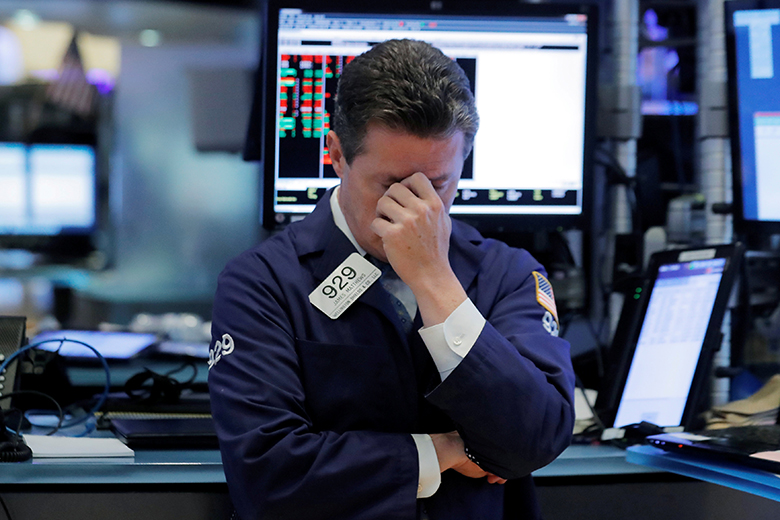There’s nothing like a rolling bear market to sort the wheat from the chaff among market strategists.
An anxious Euromoney has found calm amid the recent bond and equity market sell-off in the excellent notes many banks have kindly sent to help us through.
Citi
Citi’s private client strategy note certainly bolstered us on October 11.
“The drop in global shares in the past 24 hours is following the course of many routine corrections that have been followed by recoveries,” Citi told us, just as we were reaching for the phone to tell our broker to sell both shares in the portfolio. “Routine” sounds comforting. “We don’t advise properly diversified investors with multi-asset class portfolios to sell into such a disorderly panic,” Citi said.
We do have to admit, though, that “disorderly panic” had us reaching for the beta-blockers again.
Morgan Stanley
Morgan Stanley had already provided a helpful if short list of what to go long of amid rising rates, including: value, FX-hedged international assets and, quite convincingly to us, rates vol.
By October 16, it was ready to tout something new.
“Recent moves in rates and stocks (higher yields, lower stocks) have deviated from the traditional negative stock-bond correlations,” Morgan Stanley told us. “The diminishing ability of bonds to diversify is one reason why we created our correlation-valuation (COVA) framework, which systematically screens for assets with good diversification benefits and cheap valuations.”
Cheap assets that offer diversity sound excellent. We’re almost amazed that Morgan Stanley hadn’t thought of that before.
Deutsche Bank
By contrast, David Folkerts-Landau, group chief economist at Deutsche Bank, sounded positively ebullient on October 16.
“We have long expected interest rates to rise, and the recent market moves have ratified our forecasts.”
|
David Folkerts-Landau |
So, nothing to declare here except his… accuracy. Euromoney detects a slight want of originality, however. US interest rates have already been rising for three years.
Folkerts-Landau sees further rises ahead in Treasury and Bund yields over the next several quarters, mainly reflecting the healthy global economy. Markets are selling off because everything its going well, it seems.
Lots of other bankers are telling us this, too, so it may even be partly true.
“Equity markets have recently wilted under the pressure from higher rates, but we are not changing our view,” Folkerts-Landau writes. “Since rates are rising to reflect stronger fundamentals, it is a manageable trend for now.”
We are breathing more easily, until he adds: “Nevertheless, we have always thought that the withdrawal of the extraordinary policy stimulus would lead to more turbulence in markets, and perhaps even some nasty accidents.”
That sounds unpleasant. We certainly want to avoid any of those.
BAML
By October 18, strategists at Bank of America Merrill Lynch (BAML) were rather struggling to offer reassurance. “Markets [are] oversold,” they tell us… “yet risk can’t catch a bid.”
It reminds us of our days covering equity capital markets when bankers would tell us that the latest dog they had just floated wasn’t sinking because there were too many sellers, it’s just that there were no buyers.
BAML sums up the state of play. US Treasuries: on course for the third largest annual loss since 1970 (-9.7%). US investment grade credit: also on course for the third largest annual loss since 1970 (-3.8%). Equities: 1609 out of 2767 (58%) ACWI global stocks and 876 out of 1889 (46%) NYSE stocks in bear market territory.
“In our view, there is likely more downside on Wall Street for the next six months,” admits BAML, before perhaps considering this too troubling for investors and offering a hint of optimism: “But it should be noted that a lot of damage has already been done.”
Well that’s a relief. Isn’t it?
UBS
Mark Haefele, chief investment officer of global wealth management at UBS, is a smart fellow and subtle thinker. What can he provide?
|
Mark Haefele |
On October 18, he noted that this month’s bond sell-off has pushed real 10-year US yields to 1.03%, a seven-year high, while US cash rates are on track to be close to 3% by the end of next year, now leading some investors to question whether stock market volatility is still worth enduring.
There is a good way to see this, although perhaps better for new entrants to the markets.
“In short, investors now have more choice in their search for real returns,” writes Haefele. Choice surely is always a good thing, except perhaps if you bought equities at the top.
Time to panic
What is it about October that makes it the most susceptible month to investor panic attacks, typically accompanied by unusually high levels of stock-market volatility? DWS Investments has been considering this from the buy side with close attention to detail.
Taking daily data since 1980, average realized volatility tends to be fairly balanced for all calendar months. Only October stands out as the big exception, but that’s mainly due to the experience from just two years, 1987 and 2008.
This suggests – to DWS at least – that the latest weakness might indeed simply be just another, temporary panic attack.
“From time to time, markets get nervous, before calming down again,” DWS says, making markets sound like plucky little fellows. “It could as well be that markets have forgotten how to deal with volatility.
“After all, historically the S&P 500 has seen a 5% decline about every two months on average. We haven’t had a single 5% decline in 2017. In 2018, the time lag between panic attacks has also been longer than usual.”
Certainly, more than two months have passed since the last stock-market setback in February this year.
“Potentially, the seven-months wait until the latest panic attack in October might actually be taken as a source of reassurance for superstitious bulls.”
We’ll see. Euromoney just hopes that’s not wishful thinking.


 Signal2forex.com - Best Forex robots and signals
Signal2forex.com - Best Forex robots and signals




